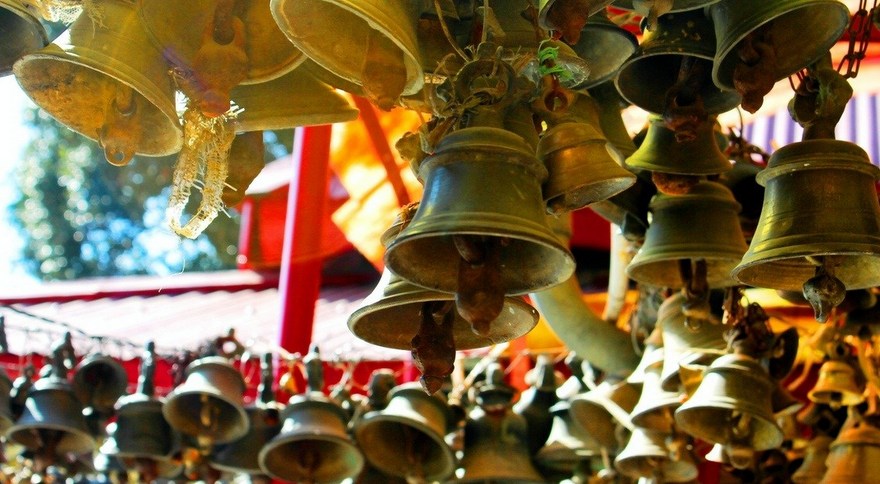The Ghanta (bell) is an integral part of our culture. Bell chimes are heard at the commencement of any puja.
The yajamana performing the ritual recites a sloka that begins as ‘Agamartham tu devanam, gamanarthantu rakshasam’ meaning ‘I ring the bell as an invocation to the divinity so that virtuous and noble forces enter and the negative forces depart’.
During the course of the puja, there is periodical ringing of the bell while making different offerings to the lord.
The toll of the bell is considered auspicious. The sound made form a well-designed ghanta is deep, continuous and sonorous. It is said to signify the primordial sabda or Omkara.
Puja bells are usually embellished with specific figures depending on the deity for whose worship it is meant. Bells used in Siva worship are cast with the figure of Nandi, or the bull which is associated with Lord Shiva. While those used in the worship of Vishnu have a figure of Garuda, panchajanya conch or Sudarsana discus.
The bells are usually made of specific metals like copper, alloys like brass or panchadhatus. It is like the proportion of each metal in alloy that determines the distinct sound produced by the bell.
It is customary for devotees visiting temples to clang the bell installed in the shrine. The intense sounds serve to momentarily empty the mind of all thoughts and awaken one to the divine presence. Bells and gongs, along with the temple lamps, fragrances and food offerings, serve to create the perfect ambiance of exalted awareness.
During the arati and other special moments in puja, the ringing of the bell is accompanied by playing of the conch and other instrument that drown any inauspicious or irrelevant thoughts and noises that might disturb worshipers in their devotional thought, concentration and inner peace.
According to the international academy of sound healing, any sacred sound can create total silence within.
The end result of this sound experience is enhanced development of intuition, creativeness and the emergence of calm within the storm of existence.
The aura, nervous and immune system are all strengthened, and the inner voice of out higher consciousness is more easily heard, they call this, ‘the return of happiness and spiritualization of matter’






















A brief and meaningful article was very interesting.
Naadam is Atharam(basis) for Sabdam and Sabdam is Atharam(basis) for Vedam. Eswari being Eswara Jhnana Rupini is Omkara Naada Rupini and Eswara is Omkara Moolam. Ghanta Naadam signifies Omkara Naadam.
Accordingly ringing a bell in a temple of the God, connects the mind of a devotee to Eswara(Almighty) because Eswari as Omkara Naada Rupini makes revolutions around Eswara as the center. Thus Ghanta Naadam makes our thought process to revolve around Eswara in the form of Maanasika Pradakshinam.
Apart from the above I have noticed in south villages and in some urban areas people wait at home to hear the Pooja , Arthi time with the sound of the bells and pray at home. Then take their food.
Interesting. The general trend is to believe all this is just superstition. And a pretext to attract attention by making noise. Understanding the deeper meaning is enlightening!
Thanks, it explained clearly the importance of the bell ringing in the Temples during pooja time. Many of them does not know why the bell is ringing at the time of pooja,
For a long time I wanted to know this . My wish has been fulfilled .
To make youngsters aware of our religious practices , Please explain Tilak , tying of thread on wrist and many others .
What is the significance of the shape of SHIVA LINGA ?
Beautifully said!
Wonderful explanation and technical by P.V.A.P. Swamy.
Thanks!
Informative
good article.
Very nicely explained
A VERY INTERESTING ARTICLE ABOUT TEMPLE BELLS.
Nice article, informative and interesting with illustrations.
It is a revelation
The vibration creates a vibration in our hearts. Very pleasant to the ears.
Yes, the bell, the nadaswaram and other instruments used during the sandhya arati stills the mind, transports to another plane; the ardent seeker longs to have this experience over and over again
Thanks.
We do need to know basics of many things/ rituals we use everyday ,but do not know their significance.
SUNDAR
I have been keenly waiting the mail’s from India divine from a long time, at last my wait is over, hope these keep on coming.
Thank you for the post.
Very very good and knowledge giving article from India Divine “WHY WE PLAY BELLS IN TEMPLES”. THANKS FOR THE SAME TO BHAKTI VEDANTA.